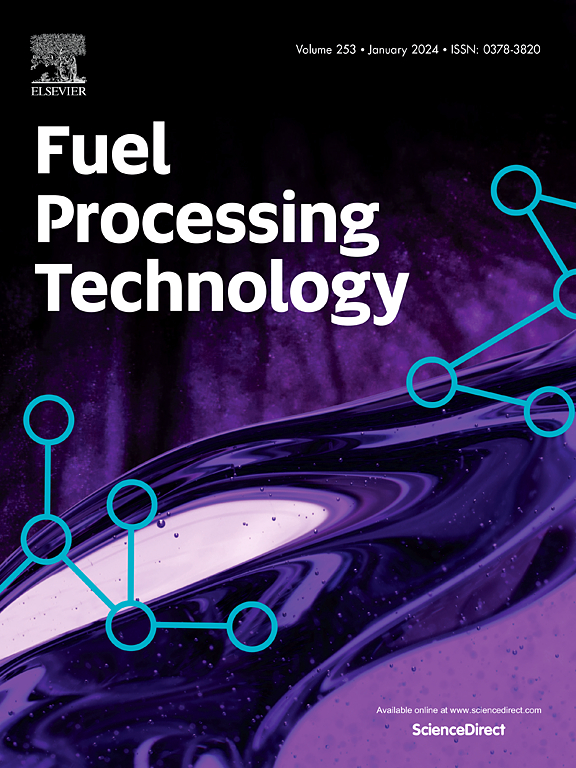非预混甲烷湍流火焰的稳定性:临界直径和火焰稳定性极限的数值模拟
IF 7.7
2区 工程技术
Q1 CHEMISTRY, APPLIED
引用次数: 0
摘要
建立了计算流体动力学(CFD)模型,并根据实验数据进行了验证,以预测非预混甲烷湍流火焰的临界直径和稳定性极限。临界直径定义了在所有驱动压力下稳定火焰持续的孔尺寸,低于此压力的稳定性依赖于压力。火焰稳定性遵循压力与释放直径的“半岛”曲线,持续的火焰高于压力上限,低于压力下限,而中间区域代表燃烧不持续的吹灭区。曲线最右边点的临界直径对于预测持续的火焰至关重要。利用可实现的k−ε模型和EDC燃烧模型,分别模拟了临界直径区域、直径和压力范围分别为15 ~ 45 mm和0.01 ~ 20 MPa,对应火焰稳定性上限和下限的甲烷释放情况。模拟准确地捕获了爆炸和持续的火焰,产生了42毫米的临界直径,与实验一致。在5.88 MPa压力下,通过50 mm孔对甲烷火焰进行了模拟,得到了火焰长度和起飞距离与实验结果一致。这些结果证实了该模型在预测甲烷火焰稳定性方面的可靠性,为安全和燃烧应用提供了有价值的见解。该研究首次基于cfd再现了全甲烷火焰稳定性曲线,验证了模型在宽压力范围内的可靠性,并为未来的应用提供了预测工具,包括评估甲烷-氢混合物的火焰稳定性。本文章由计算机程序翻译,如有差异,请以英文原文为准。
Stability of non-premixed turbulent methane flames: Numerical simulations of the critical diameter and flame stability limits
A Computational Fluid Dynamics (CFD) model is developed and validated against experimental data to predict the critical diameter and stability limits of non-premixed turbulent methane flames. The critical diameter defines the orifice size beyond which a stable flame persists at all driving pressures and below this pressure stability is pressure-dependent. Flame stability follows a “peninsula” curve of pressure versus release diameter, with sustained flames above the upper and below the lower pressure limits, while the intermediate region represents a blow-out zone where combustion is not sustained. The critical diameter, at the curve's rightmost point, is crucial for predicting sustained flames. Methane releases have been simulated for conditions in the region of the critical diameter, and for diameters and pressures ranging from 15 to 45 mm and 0.01 to 20 MPa, respectively, corresponding to the upper and lower flame stability limits using the realizable k − ε model and EDC combustion model. The simulations accurately captured blow-out and sustained flames, yielding a critical diameter of 42 mm, consistent with experiments. A methane flame at 5.88 MPa gauge through a 50 mm orifice was also simulated, showing flame length and lift-off distance in agreement with experimental observations. These results confirm the model's reliability in predicting methane flame stability, providing valuable insights for safety and combustion applications. This study presents the first CFD-based reproduction of the full methane flame stability curve, validating model reliability across a wide pressure range and providing a predictive tool for future applications, including the assessment of flame stability in methane‑hydrogen mixtures.
求助全文
通过发布文献求助,成功后即可免费获取论文全文。
去求助
来源期刊

Fuel Processing Technology
工程技术-工程:化工
CiteScore
13.20
自引率
9.30%
发文量
398
审稿时长
26 days
期刊介绍:
Fuel Processing Technology (FPT) deals with the scientific and technological aspects of converting fossil and renewable resources to clean fuels, value-added chemicals, fuel-related advanced carbon materials and by-products. In addition to the traditional non-nuclear fossil fuels, biomass and wastes, papers on the integration of renewables such as solar and wind energy and energy storage into the fuel processing processes, as well as papers on the production and conversion of non-carbon-containing fuels such as hydrogen and ammonia, are also welcome. While chemical conversion is emphasized, papers on advanced physical conversion processes are also considered for publication in FPT. Papers on the fundamental aspects of fuel structure and properties will also be considered.
 求助内容:
求助内容: 应助结果提醒方式:
应助结果提醒方式:


